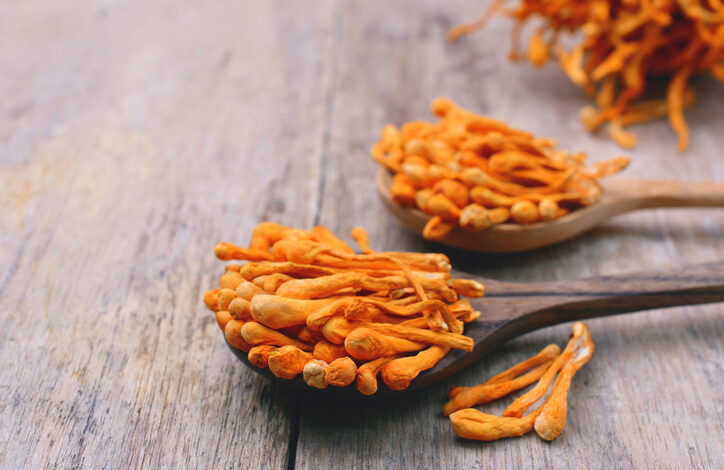What is Cordyceps Fungus & Cordyceps Benefits

My mom was an earth mother. She was a curious spirit who longed to understand and unlock more of the miracle of the world around us. She believed in the inherent goodness of nature and its wish to heal as much as she was aware that our own vulnerable human bodies are prone to self-destruction. She spoke to me about free radicals and antioxidants back when I was too young to grasp such concepts, grew organic vegetables in her lovingly-tended suburban yard while raising four kids and working full-time, and preached the many virtues of countless Chinese herbs, plants, and remedies. My mother was a veritable encyclopedia of knowledge aimed at keeping her children well.
I never did appreciate how ahead of holistic health trends she always was. Even as she fought for her life against stomach cancer, she never gave up hope that from the earth sprang the secrets of long life. It was during this time that I first caught wind of the term “functional mushrooms.”
My mom had read recent studies on cordyceps suggesting that the fungi could stimulate immune cells, and could potentially even fight some viruses and cancer. So, when Memorial Sloan Kettering Cancer Center included mention of cordyceps in their reference materials (with a caveat that further study is needed), we got on board. We went online and ordered several types of the 400 known species of these endoparasitoid fungi for her, not fully knowing what they promised yet, but trusting that she did.
Since then, this Eastern medical miracle has risen to the forefront of the wellness world. In 2020, Well+Good predicted that functional mushrooms would grow to be larger-than-life this year, and boy were they right. Adaptogens, nootropics, cordyceps—these are some of the biggest buzzwords for wellness products that have emerged in this second year of the COVID-19 pandemic.
It isn’t hard to understand why. The entire world has struggled to persist under the duress of stress unlike anything we’ve experienced ever before since the onset of the pandemic; many have battled unprecedented emotional, mental, and physical fatigue. As a result, we hope—just like my mother did—that magic mushrooms might provide some sense of relief or resolution. (And do they ever.)
But what are cordyceps, exactly, and what differentiates them from adaptogens and nootropics? Here, we tap five experts to help explain the spotlight on one of Traditional Chinese Medicine’s oldest supporting actors that’s finally being given center stage.
What is cordyceps fungus?
Although hundreds of species of cordyceps exist, for our purposes, they’re typically separated into two types, Cordyceps sinensis and Cordyceps militaris. The broad term used to categorize a group of ascomycetous fungi known to grow—are you ready?—out of insect and arthropod bodies, as Catty Khoury, founder of Toodaloo adaptogenic trail mix brand explains.
Board-certified herbalist and New Chapter director of education Charlotte Traas goes into more detail. “Another name for Cordyceps sinensis is ‘caterpillar fungus;’ it infects caterpillars and then takes over their body, eventually consuming and killing them… gross, right?” she laughs. But as Traas explains further, “This type of mushroom is extremely valuable since mushroom hunters have to go and find the caterpillar bodies and collect them. In fact, cordyceps are also historically strongly associated with Chinese royalty, used only by emperors, and called ‘soft gold’ because the price for authentic sinensis can range from $13,000 to over $140,000 per kilo.”
Cordyceps militaris, on the other hand, are a bit more palatable to the mind and the wallet. These strains are more commonly grown in a lab and fed a substrate, then harvested, Traas explains. Khoury also shares that they can be reproduced in a laboratory on sawdust, wood chips, compost, or straw.
Why are cordyceps and other functional mushrooms so hot right now?
Traditionally believed by Eastern medicine practitioners like Tom Marciano, a Doctor of Chiropractic Medicine and Certified Acupuncturist, to help balance yang energy in the body, cordyceps have long been popular in Traditional Chinese Medicine (TCM) to treat various symptoms and ailments.
“Traditional Chinese Medicine utilizes an ancient five elements theory to identify and harmonize imbalances between yin and yang,” Marciano says. This is what I, as a Chinese-American, grew up understanding as ‘hot’ or ‘cooling’ energies, not too dissimilar from the old-fashioned western concept of ‘humours.’ “To briefly oversimplify, this imbalance is expressed as symptoms of disease, which herbal concoctions are formulated to address based on what organs or elements need to be tonified or calmed,” he adds.
Although cordyceps fungus has been used in TCM for over 5,000 years to treat Jing (aka the essence of the kidney), it didn’t garner too much attention from the Western world until 1993, says Traas. “This was when some World Championship female Chinese distance runners attributed their success—including breaking three world records—to cordyceps.”
As Doctor of Preventive Medicine and co-founder of Om Mushroom Superfood Sandra Carter, M.A. MPH, Ph.D., puts it, “The western world is finally catching up with the ancient traditions of the east, and more research substantiating the various benefits of unique, functional mushrooms have been published. With increased education and awareness, there is tremendous interest in the power that mushrooms can bring to immune and cognitive health, sports performance, and more.” Indeed, many new scientific studies are starting to understand the benefits of the cordyceps cordycepin and ergosterol, among others, which have all been shown to have anti-inflammatory, neuroprotective, hypoglycemic, and renoprotective properties. Dr. Carter also says that her cordyceps products help consumers improve their endurance naturally by supporting respiration, oxygen delivery, and cellular function—which is a huge draw for athletes. “Research has shown that cordyceps can help increase endurance measured by Max V02, a test which shows the overall capacity an athlete has for exercising at a high intensity for a long duration.”
Along that vein, Dr. Carter brings up the excellent point that “We are also seeing a tremendous increase in consumer demand for adaptogens, including mushrooms.”
How do adaptogens and nootropics differ from cordyceps?
Adaptogens are broadly defined as non-toxic plants, herbs, and roots that may help boost the body’s resistance to—and tolerance of—both physical and emotional forms of stress. “Adaptogens also help to reduce the fight or flight mechanism that can cause anxiety and harmful effects to overall health,” explains Dr. Carter. And it’s no surprise to her that they’ve caught on so rapidly. “With the many challenges of this past year, people are seeking out natural products they can use on a daily basis to help them deal with anxiety, depression, and other stress-related issues,” she says.
Nootropics, on the other hand, are supplements that may contribute to a boost in mental performance, which has also been a hot topic of late as many struggle against burnout. “Nootropics are compounds that help to facilitate improvements in brain function, as related to memory, creativity, or general nerve health,” Dr. Carter explains. Generally speaking, all cordyceps are adaptogens, but they may not all be nootropics. Khoury says that Cordyceps sinensis is best for endurance and stress relief, while Cordyceps militaris is best for intense exercise and mood stability.
Buying tips for cordyceps fungus
Before you buy, keep in mind that you should speak with a physician before trying any cordyceps, adaptogens, or nootropics. And like all supplements, they are not regulated by the FDA. (And just because they’re all more popular and in fancier packaging now doesn’t make any product any more virtuous than the Chinatown and Flushing, NY herbalist shops I used to accompany my mother to as a child.)
When researching cordyceps products, Dr. Carter recommends looking for those that contain the whole functional mushroom, and look for where it was grown. “All mushrooms are bioaccumulators, which means they accumulate whatever they are grown on,” she says. “When grown in an environment with heavy metals and pesticides, all of that will all come along in the final product.” For this reason, lab-grown Cordyceps militaris is often a safer bet. “Sinensis is also extremely rare, so finding authentic samples is difficult.” When buying militaris, Traas also says to look for a company that DNA-verifies the identity of their mushrooms, like New Chapter.”
Also, keep in mind that in TCM, herbs and supplements are not meant to stand alone; rather, they tend to play a role in a compound. “Traditional Chinese Medicine often works toward balance in the body and does not usually use one herb or mushroom exclusively,” says Traas. This is why you’ll often find cordyceps and other forms of fungi blended with additional good-for-you herbs. For example, Carter’s Om Mushroom Superfood Master Blend contains three different species of functional mushrooms (including cordyceps), plus other botanical adaptogens. Her Immune Multi Boost adds vitamin C.
Khoury’s Toodaloo trail mixes also make it easy to get your blended fix. The nut mixes combine over 30 superfoods and adaptogenic herbs—including chaga, Lion’s Mane, ashwagandha, and maca—and are available in five flavors, like Smoke Show BBQ, Slow Your Roll Maple, and Deja Brew Coffee.
But again, whatever way you’d like to incorporate cordyceps, nootropics, adaptogens, or functions mushrooms into your diet, all of these experts say to first consult your doctor before steering too hard into this trend. Once you’ve been given the blessing, consider giving cordyceps and their brethren a try. After all, it all boils down to one question: Do you believe in magic?
Oh hi! You look like someone who loves free workouts, discounts for cutting-edge wellness brands, and exclusive Well+Good content. Sign up for Well+, our online community of wellness insiders, and unlock your rewards instantly.
